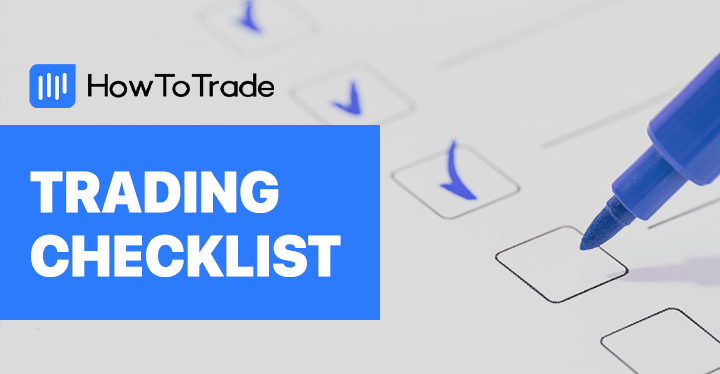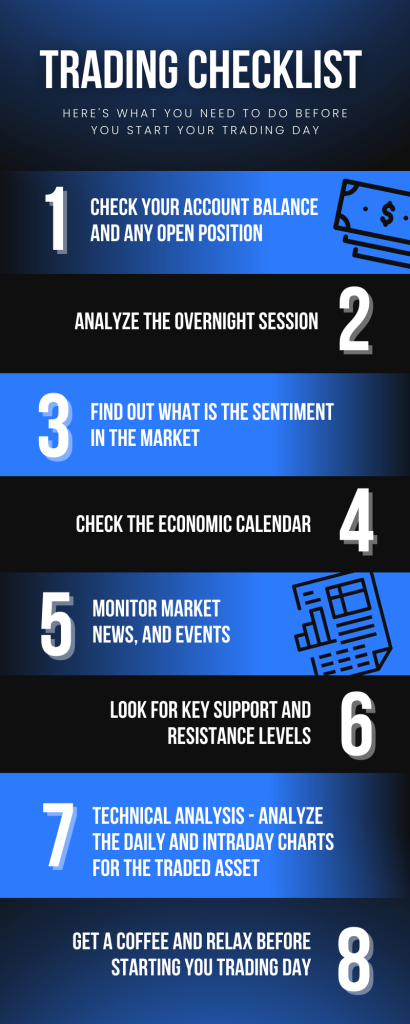
You wake up, do some stretching, have some coffee, and say, let the trading game begin. Although this sounds cool, there is more to the story.
Before taking any position, you must follow certain rules to end up with more winning trades than losing ones. And that is what we are going to show you in this article. We’ll deeply dive into what a trading checklist is, why you need one, and suggest the actions you need to take before you start your trading day.
 Table of Contents
Table of Contents
What is a Trading Checklist and Why Is It Important for a Successful Day Trading Routine?
Trading is a lot about creating a daily routine that works for you and, most importantly, sticking to it. And one of the best ways to do so is to create a trading checklist before you start your trading day.
A trading checklist aims to ensure you have considered all the relevant factors and have taken all necessary steps to increase the chances of a successful trading day. It is, therefore, not surprising that many prop trading firms and trading coaching programs require traders to develop a daily routine that involves a series of simple steps before placing the first order of the day.
A typical trading checklist may include reviewing market conditions, checking significant economic releases, setting risk management strategies, and confirming that the trade aligns with your overall investment goals and strategy.
Having a well-defined and consistent trading checklist can help you stay organized and disciplined, and therefore, it can help reduce the risk of making impulsive or reckless trades. Furthermore, it enables you to start your trading day with a positive attitude and mindset. And that is, more than anything else, the key to success in trading.
Pre-Market Trading Checklist – How to Be Ready for Your Trading Day?
Being prepared for a trading day is essential to be a successful trader. Not only will it assist you in finding trading opportunities, but it will give you the needed preparation to enter the day as you should. Remember, trading is much like sports, so it requires you to make a daily ritual trading plan before starting the battle.
So, here are the 8 steps you can take before starting your trading day:
- Check Your Account Balance and Any Open Positions
- Analyze the Overnight Session
- Find Out what is the Sentiment in the Market
- Check the Economic Calendar
- Monitor Market News and Events
- Look for Key Support and Resistance Levels
- Technical Analysis – Analyze the Daily and Intraday Charts for the Traded Asset
- Get a Coffee and Relax Before Starting Your Trading Day
Let’s explore them in more depth.
1. Check Your Account Balance and Any Open Position
Do you have an open position? If so, is it in green or red? What is your current balance? How much capital do you actually have in your account at the moment? Do you have open positions or open orders?
These are the questions you must note before taking the first trade of the day. It has to do with the psychological aspects rather than the technical ones. When you have an overnight position that isn’t in your favor, it’s better to avoid taking another trade, considering your account balance. Furthermore, if you forget an open position or an open order that is live in the market (trust me, it could happen), and you unexpectedly get an order execution, it can ruin your trading day.
So, ensure you check your account balance, purchasing power, open positions, and orders. It is a simple and quite annoying task; however, you cannot avoid it before starting your trading day.
2. Analyze the Overnight Session
While many of us look at the current price action, it’s important to look at the overnight session. This is because prices can change instantly, especially if you are trading forex or crypto, which are open 24 hours.
So, regardless of the area in which you live, you have to analyze the previous session to understand how the market behaves.
To do so, here are some of the steps you can take:
- Review the past performance of the most important assets in the market to realize the market sentiment – US dollar, Euro, major stock indices, bonds and fixed income assets, commodities, and of course… bitcoin.
- Look for any relevant economic data releases that may have impacted the markets while you were sleeping.
- Look for any trends or chart patterns in the markets that could influence your trades in the upcoming day.
3. Find Out what is the Sentiment in the Market
Is the market bullish, bearish, or moving sideways? Finding market sentiment is crucial in trading as it provides insight into market participants’ overall moods and opinions, which can greatly impact market trends and prices.
In that sense, trend traders will typically look for noise and volatility, while range traders often feel more comfortable in calm markets. Once you realize the type of trader you are, you will also learn to recognize the days you can make the highest profits.
Market sentiment can be influenced by factors such as economic data, news events, and analyst opinions; if you add analyzing sentiment analysis such as technical analysis indicators to your trading checklist, you can certainly make more informed decisions.
For analyzing forex market sentiment, you can use several tools, such as the Forex Heat Map or the currency strength meter tool. Otherwise, if you are trading the stock market, you must ensure you know what’s the general sentiment across the globe, meaning you have to analyze stock indices, futures contracts, and stock trading sentiment of other leading stock market exchanges.
4. Check the Economic Calendar
Is the Fed interest rate decision coming today? Or do we have a UK CPI coming? Checking the economic calendar is super important, as economic releases significantly impact assets’ prices.
An economic calendar lists all the news releases happening today. Central banks’ interest rate decisions, GDP, and unemployment data are all examples of economic releases.
There are many websites on which you can find an economic calendar, including HowToTrade’s economic calendar. Each event is marked as Low, Medium, and High. The high events are usually what you need to look for, and they are the ones that can turn markets upside down.
You can mark these events before you start trading, so if anything occurs between your trading hours, you are informed and can make decisions accordingly.
Having a well-defined and consistent trading checklist can help you stay organized and disciplined and, therefore, it can help reduce the risk of making impulsive or reckless trades. Furthermore, it enables you to start your trading day with a positive attitude and mindset. And that is, more than anything else, the key to success in trading.
5. Monitor Market News and Events
News plays a crucial role in trading as it can significantly impact the market. So, monitoring market news events can provide valuable information to make informed decisions rather than guesswork.
For example, major political, economic, or corporate events can lead to market volatility and create opportunities for you. News can also provide insight into the current market sentiment and help you understand market trends.
Moreover, Twitter and other social media platforms have become a powerful tool for traders, so you better open accounts on some of these platforms and learn how to use top trading hashtags and follow those who might impact financial markets (our tip – you can start with adding Elon Musk’s Twitter account).
6. Look for Key Support and Resistance Levels
Let’s move on to the technical side. There’s no way you haven’t heard about Fibonacci support and resistance levels. These price levels are the magnets from which we can identify key market reversals and essentially help traders in confirming high-probability trades. Even if you plan to trade naked, you still better check crucial support and resistance levels to identify price points throughout your trading day.
Before you start trading, it’s best to mark support and resistance levels on a longer timeframe. Even if you are a scalper, marking these levels on a longer time frame can help determine if the price will reverse or continue.
7. Technical Analysis – Analyze the Daily and Intraday Charts for the Traded Asset
Support and resistance are one aspect of technical analysis; however, you can only rely partially on them. You also have to analyze daily or intraday charts to see where the markets are heading.
If you trade a particular asset, you can look at the overall trend on multiple timeframes and then trade accordingly. For instance, if you look at GBP/USD on the 4H chart, you can locate the trend on the daily chart to confirm the overall trend.
One thing to note is even though short-term trading seems like a fun idea, it’s better to analyze longer time frame charts, as there is a lot of noise on shorter timeframes.
8. Get a Coffee and Relax Before Starting You Trading Day
Starting your trading day can be stressful and demanding, but enjoying a coffee and relaxing before diving in can make all the difference. A hot cup of coffee can be a calming ritual, helping to clear your mind and prepare you for the challenges ahead.
Much like athletes or poker players who have a ritual before stepping onto the court, trading is a mental game, and as such, you must start with a positive and relaxing mindset.
So, take a step back, get a coffee, and give yourself a moment to relax before the hustle and bustle of the upcoming trading day. A well-deserved break can help set the tone for a productive and successful day ahead.
More than that, if things do not work well throughout the trading day, take another break and come back later. The market is always here, but your mind is not. So ensure that you are always in full focus when you are trading.
Trading Checklist Infographic (FREE Download)
Here, you can download our trading checklist that includes the 8 essential steps to starting your trading day. Just right-click on your mouse and click on “Save image as…”.

How to Prepare for Your Trading Day with HowToTrade
By taking these steps above, you can increase your chances of making informed and successful trades and always be ready for a successful trading day. It might seem unnecessary, but there’s a reason why many prop trading firms require their prop traders to develop a daily routine setup before making any trade.
Additionally, we invite you to join our trading academy, where you can get access to daily live streams with our trading coaches and integrate our service with your daily morning routine. There, we cover the most important data to look at and provide insights for the upcoming trading day. With 6-8 live streams each day, you can improve your trading process by quickly understanding what drives the markets and the key economic data to look for every day and every minute of the day.
Risk Disclosure: The information provided in this article is not intended to give financial advice, recommend investments, guarantee profits, or shield you from losses. Our content is only for informational purposes and to help you understand the risks and complexity of these markets by providing objective analysis. Before trading, carefully consider your experience, financial goals, and risk tolerance. Trading involves significant potential for financial loss and isn't suitable for everyone.



